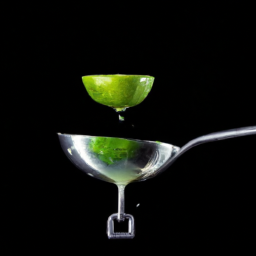I’ve always loved the tangy taste that lime juice brings to my drinks and meals. But because I have trouble judging amounts visually, I often wonder how much juice one lime can yield.
After some experimentation and research, I’ve discovered that the answer depends on a variety of factors, including the size and freshness of the lime, as well as the method used to extract the juice.
In this article, I’ll be sharing my findings on how to get the most juice out of your limes, as well as tips for measuring and storing lime juice.
Whether you’re making a classic margarita or adding some zest to your favorite dish, understanding how much lime juice to use can make all the difference in achieving the perfect balance of flavors.
So let’s dive in and explore the world of lime juice!
Key Takeaways
- One lime yields 1-2 tablespoons of juice.
- Factors affecting lime juice yield include ripeness, temperature, and juicing technique.
- Lime juice can be measured in both metric and imperial systems.
- Tips for maximizing yield include rolling, microwaving, cutting off ends, using a juicer or reamer, and poking holes with a fork.
Factors Affecting Lime Juice Yield
The amount of lime juice that can be extracted from a lime depends on several factors, such as its ripeness and temperature. Lime juice yield is at its highest when limes are fully ripe, which means they’re softer and juicier.
Additionally, limes that are at room temperature or slightly warmer are easier to juice than those that are cold. Juicing techniques and lime varieties also play a role in juice yield.
Some lime varieties, such as Persian limes, are juicier than others. When it comes to juicing techniques, using a citrus juicer can help maximize juice yield by applying pressure evenly to the fruit.
With this in mind, let’s move on to the next section about using a citrus juicer to extract lime juice efficiently.
Using a Citrus Juicer
When you’re using a citrus juicer, you’ll want to cut your lime into small wedges to ensure maximum juice extraction. You can also remove the seeds before juicing to prevent the bitterness of the lime seeds from getting into the juice.
Citrus juicers are a popular choice for those who want to extract as much juice as possible from their limes. Other citrus juicer alternatives include electric and manual juicers.
However, some people prefer the benefits of hand juicing. Hand juicing allows you to have more control over the amount of juice extracted from the lime. It’s also a great option if you only need to juice a small amount of limes. Plus, it’s a more affordable option compared to purchasing a citrus juicer.
But if you need to juice a large quantity of limes, using a manual juicer may be more efficient.
Using a Manual Juicer
To get the most out of your manual juicer, you’ll want to firmly press down and twist the lime to release all the flavorful juice. But there are a few other techniques you can use to ensure that you’re squeezing efficiently.
First, try warming the lime up slightly by rolling it on the counter or microwaving it for a few seconds. This can help break down the fibers and make it easier to extract the juice.
Second, cut the lime in half crosswise, rather than lengthwise. This will give you a wider surface area to press down on and can result in more juice.
Third, use a spoon or your fingers to loosen up the pulp inside the lime before juicing. This can help release even more juice.
When you’re done juicing your lime, it’s important to take the time to properly clean and maintain your manual juicer.
Start by disassembling the juicer and washing each piece thoroughly with warm, soapy water. Use a brush or toothbrush to scrub away any pulp or juice residue. Rinse each piece thoroughly and allow it to air dry before reassembling.
To keep your juicer functioning properly, check for any signs of wear or damage and replace any parts as needed.
With these techniques for squeezing efficiently and tips for maintaining your manual juicer, you’ll be able to enjoy fresh lime juice whenever you want.
Now, let’s move on to the next section about using a fork or spoon to extract juice from a lime.
Using a Fork or Spoon
When I don’t have a juicer or citrus reamer handy, I often turn to a fork or spoon to extract the juice from a lime. Using a fork or spoon has its advantages – it’s quick, easy, and doesn’t require any special equipment.
To use a fork, I simply cut the lime in half and then press and twist the fork into the flesh of the lime. Using a spoon involves scooping out the flesh and squeezing it over a bowl.
Advantages of Using a Fork or Spoon
Using a fork or spoon to extract lime juice has its advantages – it’s quicker and easier than squeezing by hand! When cooking or baking, using utensils like a fork or spoon can help you mix ingredients evenly and efficiently.
Both utensils can be used interchangeably, but they do have their differences. A fork can be used to mash or break up chunks of ingredients, while a spoon is better for stirring and scooping.
One of the benefits of using utensils for cooking is that you can avoid getting your hands messy. When using a fork or spoon to extract lime juice, you can easily pierce the fruit and twist it to release the juice without getting any on your hands. Plus, using utensils can save you time – instead of squeezing the lime by hand, you can extract the juice in seconds with a fork or spoon.
With these advantages in mind, let’s move on to how to extract lime juice using a fork or spoon.
How to Use a Fork or Spoon
Now that we’ve discussed the advantages of using a fork or spoon for juicing, let’s talk about how to use them effectively. Personally, I prefer using a fork as it allows me to extract more juice from the lime without having to put as much pressure on it. However, both utensils can be used interchangeably and it ultimately comes down to personal preference.
To help you get the most out of your lime, I’ve created a table outlining the dos and don’ts of using a fork or spoon for juicing:
| Dos | Don’ts |
|---|---|
| Use a fork to poke holes in the lime before squeezing | Use a spoon to scoop out the pulp |
| Hold the lime in your non-dominant hand and press the fork/spoon into the lime with your dominant hand | Use too much pressure and break the lime |
| Rotate the lime and squeeze it gently to extract the juice | Allow seeds to fall into the juice |
By following these tips, you’ll be able to effectively juice a lime without running into common mistakes. However, if you’re looking for an even easier way to juice fruits, consider using a blender.
Using a Blender
Blend your lime with just a splash of juice for a perfectly tangy smoothie. While a blender’s the most efficient way to blend a lime, there are alternatives if you don’t have one. You can use a food processor, immersion blender, or even a mortar and pestle. However, keep in mind that using a blender will give you the smoothest consistency.
When blending with a blender, start by cutting your lime into quarters and removing any seeds. Add the lime quarters and a small amount of juice to the blender and blend until smooth. If the mixture’s too thick, add a little more juice or water to thin it out.
Once you have blended your lime, you can move on to measuring out the juice for your recipe. Measuring lime juice can be tricky, as the amount of juice you get from one lime can vary. Generally, one lime contains about 1-2 tablespoons of juice.
To ensure you get the right amount, try to use a juicer or citrus press. Alternatively, you can hand-squeeze your lime over a small strainer to catch any seeds or pulp.
Now that you know how to blend and measure your lime juice, you’re ready to take on any lime-based recipe.
Measuring Lime Juice
When it comes to measuring lime juice, the key is to be precise. One lime typically yields about 2 tablespoons of juice, but this can vary depending on the size and ripeness of the fruit.
If a recipe calls for a specific amount of lime juice and you only have whole limes, it’s important to know how to convert the measurement accurately.
How to Measure Lime Juice
To measure lime juice, all you need to do is cut a lime in half and squeeze it! This is the easiest and most straightforward method for getting lime juice. However, if you don’t have a citrus squeezer, you can also use a fork or a juicer to extract the juice. Alternatively, you could also buy pre-squeezed lime juice from the store.
Measuring lime juice is important for many recipes, as the amount of juice can greatly affect the taste and texture of a dish. Measuring out the juice ensures that you’re using the exact amount needed for the recipe, which can make a big difference in the final result. By measuring the juice, you can also control the acidity level of the dish and adjust it to your taste.
Now that we know how to measure lime juice, let’s explore how to convert lime juice measurements for different recipes.
Converting Lime Juice Measurements
Now that we know how to measure lime juice, it’s important to understand how to convert these measurements. Converting lime juice measurements can be a bit tricky, especially when dealing with different measurement systems.
There are two main measurement systems used in cooking: metric and imperial. Metric measurements are used in most countries around the world, while imperial measurements are used primarily in the United States. When it comes to measuring lime juice, it’s important to know how to convert between these two systems.
For example, one lime typically yields about 30 milliliters of juice, which is equivalent to 1 fluid ounce in imperial measurements.
In addition to understanding measurement conversions, it’s also important to know how much lime juice is needed in common recipes. Lime juice is a popular ingredient in a variety of dishes, including guacamole, ceviche, and margaritas.
A basic guacamole recipe, for example, typically calls for the juice of one lime, while a pitcher of margaritas may require several limes’ worth of juice. By understanding these common uses, we can ensure that we have enough lime juice on hand to complete our desired recipes.
With these tips in mind, we can now move on to exploring how to maximize our lime juice yield.
Tips for Maximizing Lime Juice Yield
Get the most out of your lime by using these simple tips to extract the maximum amount of juice from each fruit. First, roll the lime firmly on a hard surface with the palm of your hand. This helps to break down the membranes inside the lime, making it easier to extract the juice.
Next, microwave the lime for a few seconds to warm it up. This also helps to loosen the juice and makes it easier to extract. Alternative methods for maximizing lime juice yield include cutting off the ends of the lime and using a citrus juicer or a reamer to extract the juice.
Additionally, you can use a fork to poke holes in the lime before squeezing to help release the juice. Remember, lime juice benefits include being a good source of vitamin C and antioxidants, so getting the most out of each lime can be beneficial for your health.
Now that you have extracted all of the juice from your lime, it’s time to learn how to properly store it.
Storing Lime Juice
Properly storing your lime juice is crucial for maintaining its freshness and flavor. After squeezing your limes, there are different options for storing your lime juice depending on how long you plan to keep it.
If you’re using your lime juice within a few hours, you can store it in an airtight container in the fridge. This will keep it cool and prevent it from being exposed to air, which can cause it to spoil faster.
If you’re planning to keep your lime juice for longer, you can freeze it in ice cube trays. Simply pour your lime juice into the trays and freeze them. Once they’re frozen, you can transfer them to a freezer-safe container or bag. This will extend the shelf life of your lime juice for up to six months. When you’re ready to use them, simply thaw them out in the fridge or at room temperature.
With these storage options, you can keep your lime juice fresh and flavorful for all your recipe needs.
When it comes to recipe ideas using lime juice, there are countless options. From adding it to marinades and dressings to using it in cocktails and desserts, lime juice can add a zesty and refreshing kick to any dish.
So now that we’ve covered how to store your lime juice, let’s move on to some delicious recipe ideas to put it to use.
Recipe Ideas Using Lime Juice
With a touch of citrusy flavor, adding a dash of lime juice to your favorite recipes can truly elevate the taste.
Lime juice marinades are a popular way to add a zesty flavor to meats and vegetables. Simply mix lime juice with some oil, herbs, and spices, and let your meat or veggies marinate for a few hours or overnight. The result is a dish bursting with flavor that will have your taste buds dancing.
Lime juice is also a popular ingredient in cocktails, adding a refreshing kick to classic drinks like margaritas and mojitos. A splash of lime juice can make all the difference in a well-balanced cocktail.
You can experiment with different ratios of lime juice to other ingredients to find the perfect balance for your taste buds. So, whether you’re cooking up a storm in the kitchen or mixing up drinks at your next party, don’t be afraid to add a little lime juice to your recipes.
Frequently Asked Questions
How do I know if a lime is ripe and ready to be juiced?
To tell if a lime is ripe, gently squeeze it. A ripe lime will give slightly. For juicing, roll the lime on a hard surface before cutting to release more juice. Use a citrus juicer to get the most juice out.
Can I substitute bottled lime juice for fresh lime juice in recipes?
Yes, you can substitute bottled lime juice for fresh lime juice in recipes, but there may be differences in taste and nutritional value. To extend the shelf life of bottled lime juice, store it in the refrigerator after opening and consume before the expiration date.
How long can I store freshly squeezed lime juice?
Did you know that freshly squeezed lime juice can last for up to five days when stored properly? To extend the shelf life of lime juice, store it in an airtight container in the fridge.
Does the temperature of the lime affect the amount of juice it yields?
I’ve found that the temperature of limes can affect the yield of juice. When using Lime squeezing techniques and Lime juice extraction methods, slightly warming the lime can result in more juice. However, overheating the lime can reduce the yield.
Can I freeze lime juice for later use?
I’ll freeze lime juice for later use, but it may affect its taste and texture. To maintain quality, freeze in an airtight container, leaving room for expansion, and use within 6 months. Thaw in the fridge and shake before using.
Conclusion
Well, that’s all you need to know about getting the most juice out of your lime! Remember, the yield can vary based on the size of the lime and the method used to extract the juice. On average, one lime produces about 2 tablespoons of juice, which is enough for most recipes.
It’s amazing how one little lime can pack such a punch of flavor in so many dishes. Did you know that in the United States alone, we consume over 2 billion limes each year? That’s a lot of lime juice!
So whether you’re making guacamole, margaritas, or adding a squeeze of lime to your favorite dish, now you know how to get the most out of your lime. Happy juicing!
Ilana has been a vegan for over 10 years. She originally made the switch for health reasons, but soon found herself becoming more and more passionate about the ethical and environmental implications of a vegan lifestyle. Ilana is the author of The Graceful Kitchen, a blog all about veganism. She loves to cook up delicious and nutritious vegan meals, and share her recipes with others who are interested in leading a cruelty-free life. Ilana is also a strong advocate for using whole foods as the foundation of a healthy diet, and believes that going vegan is one of the best ways to achieve this.










